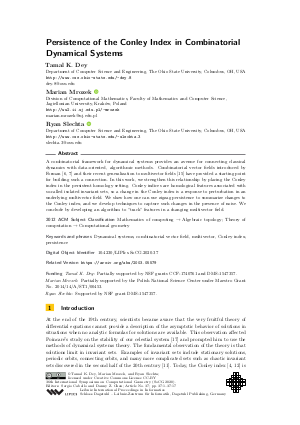Persistence of the Conley Index in Combinatorial Dynamical Systems
Authors
Tamal K. Dey,
Marian Mrozek  ,
Ryan Slechta
,
Ryan Slechta 
-
Part of:
Volume:
36th International Symposium on Computational Geometry (SoCG 2020)
Part of: Series: Leibniz International Proceedings in Informatics (LIPIcs)
Part of: Conference: Symposium on Computational Geometry (SoCG) - License:
 Creative Commons Attribution 3.0 Unported license
Creative Commons Attribution 3.0 Unported license
- Publication Date: 2020-06-08
File

PDF
LIPIcs.SoCG.2020.37.pdf
- Filesize: 4.04 MB
- 17 pages
Document Identifiers
Related Versions
Subject Classification
ACM Subject Classification
- Mathematics of computing → Algebraic topology
- Theory of computation → Computational geometry
Keywords
- Dynamical systems
- combinatorial vector field
- multivector
- Conley index
- persistence
Metrics
- Access Statistics
-
Total Accesses (updated on a weekly basis)
0Document
0Metadata
Abstract
A combinatorial framework for dynamical systems provides an avenue for connecting classical dynamics with data-oriented, algorithmic methods. Combinatorial vector fields introduced by Forman [R. Forman, 1998; R. Forman, 1998] and their recent generalization to multivector fields [Mrozek, 2017] have provided a starting point for building such a connection. In this work, we strengthen this relationship by placing the Conley index in the persistent homology setting. Conley indices are homological features associated with so-called isolated invariant sets, so a change in the Conley index is a response to perturbation in an underlying multivector field. We show how one can use zigzag persistence to summarize changes to the Conley index, and we develop techniques to capture such changes in the presence of noise. We conclude by developing an algorithm to "track" features in a changing multivector field.
Cite As Get BibTex
Tamal K. Dey, Marian Mrozek, and Ryan Slechta. Persistence of the Conley Index in Combinatorial Dynamical Systems. In 36th International Symposium on Computational Geometry (SoCG 2020). Leibniz International Proceedings in Informatics (LIPIcs), Volume 164, pp. 37:1-37:17, Schloss Dagstuhl – Leibniz-Zentrum für Informatik (2020)
https://doi.org/10.4230/LIPIcs.SoCG.2020.37
BibTex
@InProceedings{dey_et_al:LIPIcs.SoCG.2020.37,
author = {Dey, Tamal K. and Mrozek, Marian and Slechta, Ryan},
title = {{Persistence of the Conley Index in Combinatorial Dynamical Systems}},
booktitle = {36th International Symposium on Computational Geometry (SoCG 2020)},
pages = {37:1--37:17},
series = {Leibniz International Proceedings in Informatics (LIPIcs)},
ISBN = {978-3-95977-143-6},
ISSN = {1868-8969},
year = {2020},
volume = {164},
editor = {Cabello, Sergio and Chen, Danny Z.},
publisher = {Schloss Dagstuhl -- Leibniz-Zentrum f{\"u}r Informatik},
address = {Dagstuhl, Germany},
URL = {https://drops.dagstuhl.de/entities/document/10.4230/LIPIcs.SoCG.2020.37},
URN = {urn:nbn:de:0030-drops-121958},
doi = {10.4230/LIPIcs.SoCG.2020.37},
annote = {Keywords: Dynamical systems, combinatorial vector field, multivector, Conley index, persistence}
}
Author Details
- Department of Computer Science and Engineering, The Ohio State University, Columbus, OH, USA
- Division of Computational Mathematics, Faculty of Mathematics and Computer Science, Jagiellonian University, Kraków, Poland
Funding
- Dey, Tamal K.: Partially supported by NSF grants CCF-1740761 and DMS-1547357.
- Mrozek, Marian: Partially supported by the Polish National Science Center under Maestro Grant No. 2014/14/A/ST1/00453.
- Slechta, Ryan: Supported by NSF grant DMS-1547357.
References
-
J. A. Barmak. Algebraic Topology of Finite Topological Spaces and Applications. Lecture Notes in Mathematics 2032. Springer Verlag, Berlin - Heidelberg - New York, 2011.

-
N. P. Bhatia and G. P. Szegö. Dynamical Systems: Stability Theory and Applications. Lecture Notes in Mathematics 35. Springer Verlag, Berlin - Heidelberg - New York, 1967.

- Gunnar Carlsson and Vin de Silva. Zigzag persistence. Foundations of Computational Mathematics, 10(4):367-405, August 2010. URL: https://doi.org/10.1007/s10208-010-9066-0.
-
C. Conley. Isolated invariant sets and the Morse index. In CBMS Regional Conference Series 38, American Mathematical Society, 1978.

- Tamal K. Dey, Mateusz Juda, Tomasz Kapela, Jacek Kubica, Michal Lipinski, and Marian Mrozek. Persistent homology of Morse decompositions in combinatorial dynamics. SIAM Journal on Applied Dynamical Systems, 18(1):510-530, 2019. URL: https://doi.org/10.1137/18M1198946.
- R. Forman. Combinatorial vector fields and dynamical systems. Mathematische Zeitschrift, 228:629-681, 1998. URL: https://doi.org/10.1007/PL00004638.
- R. Forman. Morse theory for cell complexes. Advances in Mathematics, 134:90-145, 1998. URL: https://doi.org/10.1006/aima.1997.1650.
-
J. Hale and H. Koçak. Dynamics and Bifurcations. Texts in Applied Mathematics 3. Springer-Verlag, 1991.

-
Allen Hatcher. Algebraic Topology. Cambridge University Press, Cambridge, 2002.

- Michał Lipiński, Jacek Kubica, Marian Mrozek, and Thomas Wanner. Conley-Morse-Forman theory for generalized combinatorial multivector fields on finite topological spaces. arXiv:1911.12698 [math.DS], 2019. URL: http://arxiv.org/abs/1911.12698.
- Edward N. Lorenz. Deterministic Nonperiodic Flow, pages 25-36. Springer New York, New York, NY, 2004. URL: https://doi.org/10.1007/978-0-387-21830-4_2.
-
K. Mischaikow and M. Mrozek. The Conley Index. Handbook of Dynamical Systems II: Towards Applications. (B. Fiedler, ed.) North-Holland, 2002.

- K. Mischaikow, M. Mrozek, J. Reiss, and A. Szymczak. Construction of symbolic dynamics from experimental time series. Physical Review Letters, 82:1144-1147, February 1999. URL: https://doi.org/10.1103/PhysRevLett.82.1144.
- Konstantin Mischaikow and Marian Mrozek. Chaos in the Lorenz equations: a computer-assisted proof. Bulletin of the American Mathematical Society, 33:66-72, 1995. URL: https://doi.org/10.1090/S0273-0979-1995-00558-6.
- Marian Mrozek. Conley-Morse-Forman theory for combinatorial multivector fields on Lefschetz complexes. Foundations of Computational Mathematics, 17(6):1585-1633, December 2017. URL: https://doi.org/10.1007/s10208-016-9330-z.
-
J.R. Munkres. Topology. Featured Titles for Topology Series. Prentice Hall, Incorporated, 2000.

-
H.J. Poincaré. Sur le probleme des trois corps et les équations de la dynamique. Acta Mathematica, 13:1-270, 1890.

